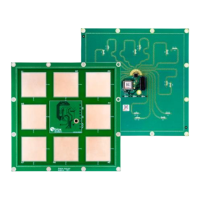XPLR-AOA-3 - User guide
UBX-22006906 - R07 ANT-B10 Page 10 of 46
C1-Public
3.2 Flashing from the Command line
To flash the software over the UART interface from the Command line:
1. Download the u-connectLocate software container from the u-connectLocate product page [4].
2. Put the device into firmware update mode; either:
a. Enter the AT+UFWUPD command [11] to select the appropriate baud rate. The following
command sets the baud rate to 1Mbit/s.
AT+UFWUPD=0,1000000
b. Boot the board into Software Update mode by connecting the SWITCH_2 pin to ground
while powering up the board. This sets the default baud rate to 115200.
3. Flash the u-connectLocate software using the bundled (Windows only) newtmgr executable.
Alternatively, follow the Newt Manager Guide [6] to install the newtmgr application tool for MAC
OS, Linux, and Windows.
4. Use newtmgr to install u-connectLocate software on the NINA-B411 module:
newtmgr --conntype=serial --connstring="COMXX,baud=XXX,mtu=512" image upload <binary
image>
5. Press the reset button to reset the application board or reset it with newtmgr:
newtmgr --conntype=serial --connstring="COMXX,baud=XXX" reset
☞ Replace COMXX with your actual port number, baud=XXX, to either the default baud rate of 115200
or your chosen baud rate.
3.3 ANT-B10 configuration and testing
A green LED light indicates that the board is powered on.
Having connected the COM port, the board is ready to receive AT commands. For information about
the AT commands to use for configuring direction finding, see the u-connectLocate AT commands
manual [18].
s-center supports specific direction-finding AT commands in the Angle of Arrival tab, as shown in
Figure 8. The COM port can also be used with a terminal emulator to type in AT commands.
Once the system is setup, each anchor reports angle calculation events (+UUDF) over the serial port
connection. When ANT-B10 detects a beacon it reports events like this:
+UUDF:CCF9578E0D8A,-42,20,0,0,37,”CCF9578E0D89”,””,15869,23
+UUDF:CCF9578E0D8B,-41,10,4,0,38,”CCF9578E0D89”,””,15892,24
+UUDF:CCF9578E0D8A,-42,-10,2,0,39,”CCF9578E0D89”,””,15921,25
…
The data reported in these events can be used to estimate a position of the tracked beacon. The
parameters of the +UUDF event are (from left to right):
• Eddystone instance ID
• RSSI of 1
st
polarization
• Angle 1
• Angle 2
• Reserved
• Detected channel
• Anchor ID as set by AT+UDFCFG tag 4.
• User defined strings as set by AT+UDFCFG tag 2.
• Timestamp
• Periodic advertising sequence number
In the events reported above, the beacon is moving from one side of the anchor to the other as angle1,
which is given as the third parameter in the event (shown in bold).

